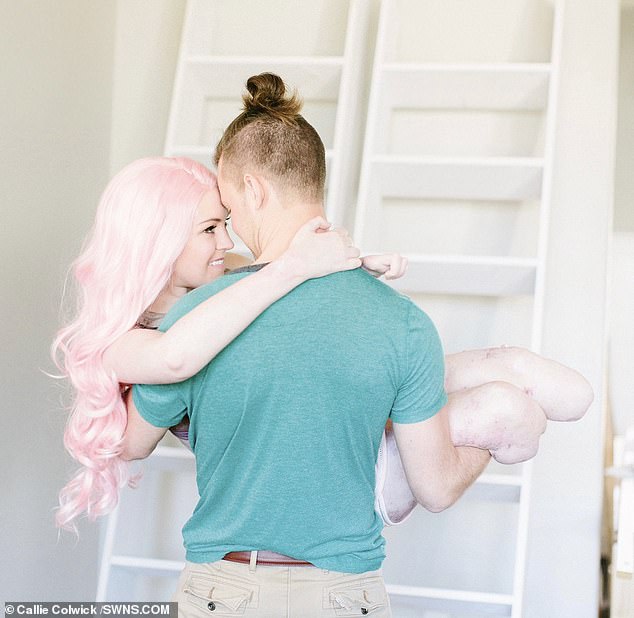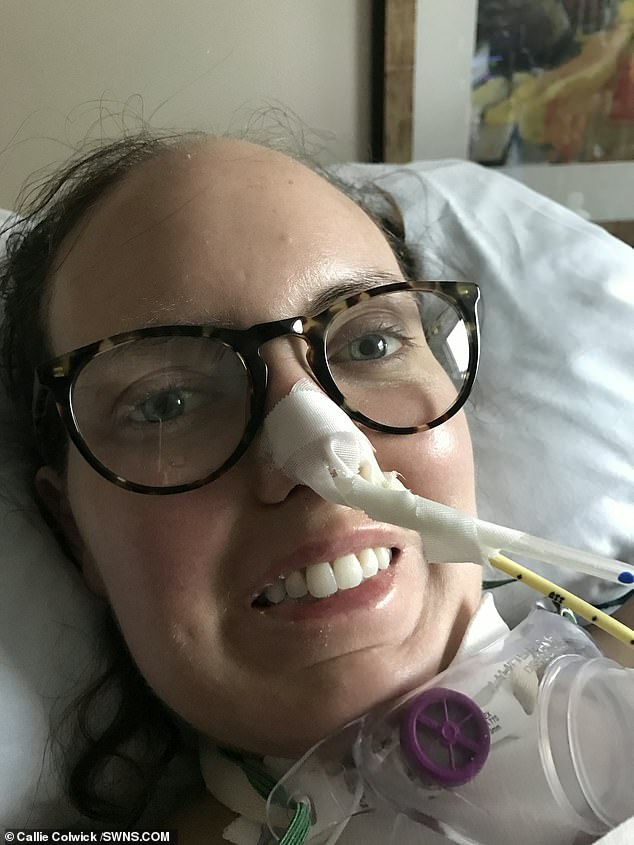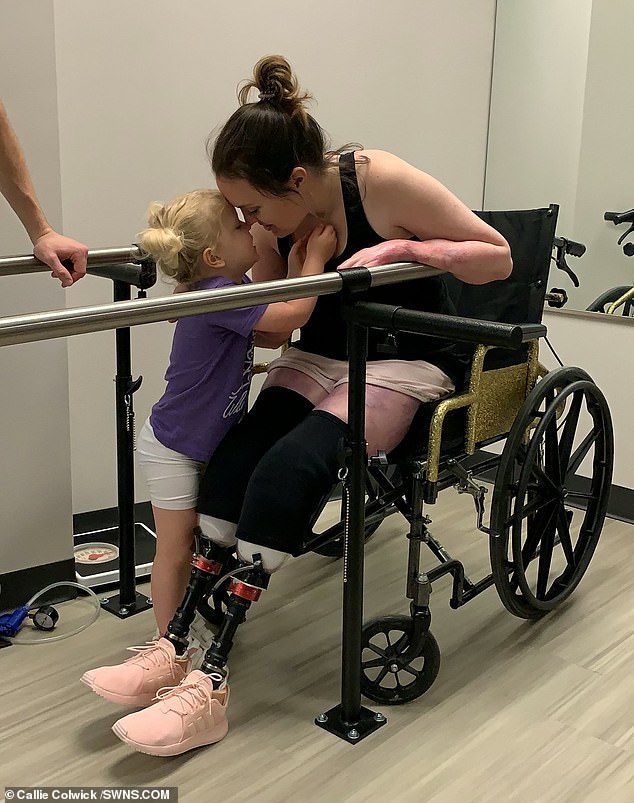Brave mother tells how she had to have her lower legs amputated due to sepsis after life-threatening childbirth to her tragically stillborn son
- Callie Colwick, 30, suffered a major pregnancy complication, placenta accreta
- At 15 weeks, she and her husband were told Quinn would not survive the birth
- Two weeks later Mrs Colwick was induced and gave birth to Quinn stillborn
- During the traumatic labour, Mrs Colwick was heavily bleeding and got sepsis
- Doctors had no choice but to amputate both her lower legs, a thumb and finger
- Mrs Colwick spent almost two years in various hospitals including rehab
A brave mother had her lower legs amputated due to sepsis after a life-threatening labour during which she gave birth to her stillborn baby.
Callie Colwick, 30, from McKinney, Texas, suffered from placenta accreta while pregnant with her son Quinn, a rare serious condition with major complications.
At 15 weeks, she and her husband Kevin, 30, were told Quinn could be born at any time and that tragically he would not survive the birth.
Two weeks later, in December 2016, Mrs Colwick was induced and gave birth to Quinn while unconscious, who was tragically stillborn weighing just half a pound.
During the traumatic labour, Mrs Colwick was heavily bleeding and her blood pressure dropped drastically low, called septic shock.
She then developed deadly sepsis, which shut down her kidneys and lungs. She was put on life support while Mr Colwick was told to prepare for the worst.
Two months later, doctors had no choice but to amputate both of Mrs Colwick’s lower legs, her left thumb and forefinger because blood was unable to reach them.
Her insides were ‘black and dead’, leading to the removal of her uterus. Mrs Colwick was fed through a tube and needed skin grafts on her backside due to spending some much time in a hospital bed.
Mrs Colwick spent almost two years in various hospitals including rehab, and finally returned home to her daughter, Kenzi, in March 2018.
Her health insurance refused to cover the $ 11,000 (£8,555) custom wheelchair she needed to move around freely, and the money was raised by an inspired stranger.

At 15 weeks pregnant, Callie Colwick, 30, from McKinney, Texas, and her husband Kevin, 30, (pictured together) were told their son Quinn would not survive the birth

Mrs Colwick’s lower legs were amputated (pictured) due to sepsis after the life-threatening labour, during which she gave birth to Quinn stillborn. She is pictured with Mr Colwick and their daughter, Kenzi. Her hair was removed while she was in hospital

Mrs Colwick suffered from placenta accreta while pregnant with her son Quinn, a serious condition with major complications. She is pictured recently being held by her husband

Mrs Colwick developed deadly sepsis, which shut down her kidneys and lungs. She was put on life support while Mr Colwick was told to prepare for the worst
Mrs Colwick, a graphic de
signer, and her husband, a web developer, were delighted to discover they were pregnant with their second child in November 2016.
But when Mrs Colwick began experiencing heavy bleeding at work when she was 15 weeks pregnant, she went to hospital.
‘I’d had light bleeding from day one,’ Mrs Colwick said. ‘But what made me go to the doctor was the heavy abdominal bleeding.
‘I was passing blood clots. I was at work about to go into a meeting and I felt this gush of liquid – my pants were soaked in blood.’
Mrs Colwick was diagnosed with placenta accreta, which is when the placenta—the organ that provides nutrients and other support to a developing foetus —attaches too deeply to the uterine wall.
The main major complication is that the placenta cannot normally deliver after the baby’s birth, and attempts to remove the placenta can lead to heavy bleeding.
Risks to the baby include premature birth. If there is early, heavy bleeding, then the delivery may need to occur very early because the mother may become unstable.
Doctors told Mrs Colwick that Quinn tragically he would not survive birth at such an early age – 17 weeks gestation.


Mrs Colwick, a graphic designer, and her husband, a web developer, were delighted to discover they were pregnant with their second child in November 2016

Speaking of her labour, Mrs Colwick said: ‘I was fading in and out of consciousness. I wasn’t responsive, my eyes would roll to the back of my head and I was burning up’
Mrs Colwick said: ‘They put me in the pregnancy wing. Here we were in this room, surrounded by women giving birth and babies crying and we were told that Quinn had no chance of survival and we were just waiting to give birth to him.
‘It was a solemn few weeks.’
Doctors induced labour on December 26 2016 and little Quinn was stillborn, weighing just half a pound.
‘I was fading in and out of consciousness,’ Mrs Colwick said. ‘I wasn’t responsive, my eyes would roll to the back of my head and I was burning up.
‘My fever had spiked way too high and they were packing ice onto me.
‘They broke my waters and he was born. Quinn was too tiny to survive; he went straight to heaven.
‘My husband was stuck between mourning the loss of his son and making all these medical decisions.’
During the delivery Mrs Colwick lost so much blood that a trauma doctor was flown in from Dallas.
‘My uterus was haemorrhaging blood. Doctors were pumping blood into me as soon as it was flowing out.’
Mrs Colwick developed septic shock, when blood pressure drops to a dangerously low level. It is also considered part of the third, and most serious stage of sepsis.
An infection, which doctors believe was E. coli, led to sepsis – the body’s overwhelming and life-threatening response to infection that can lead to tissue damage, organ failure, and death.

During the delivery Mrs Colwick lost so much blood that a trauma doctor was flown in from Dallas. She developed septic shock, when blood pressure drops to a dangerously low level

Doctors had no choice but to amputate both of Mrs Colwick’s lower legs, her left thumb and forefinger because blood was unable to reach them. She is pictured at home with Kenzie

Mrs Colwick, whose left thumb and forefinger were amputated, said: ‘My limbs started to die. My legs were black and shrivelled up, my toes looked like raisins’
Mrs Colwick said: ‘My world went black. That infection overrode my entire body.
‘The sepsis shut down my kidneys and my lungs so I was on a breathing machine.’
‘My limbs started to die. My legs were black and shrivelled up, my toes looked like raisins.’
Two months later, doctors decided that they would have to amputate Mrs Colwick’s legs below the knee and part of her left hand as the tissue was so damaged due to lack of blood.
She said: ‘I remember coming to, in extreme pain and confusion. My husband had to explain what happened. I had everything minus my uterus and my feet.’
Doctors had also removed Mrs Colwick’s uterus because the tissue had ‘died’.
From January to February 2017, Mrs Colwick was given ‘no chance of survival’. She spent April to September in ICU and had various surgeries.
Finally in March 2018 she was able to return home.
She had been refused prosthetics by her health insurance and struggled to adjust to life as an amputee in a bulky wheelchair that she could not push herself in.
‘The wheelchair they sent me home in was a basic chair off of Amazon.
‘Kevin had to dress my wounds every day.’

Mrs Colwick had initially been refused prosthetics by her health insurance. In April 2019 she was finally approved for prosthetics (pictured)

Mrs Colwick was fed through a tube and needed skin grafts on her backside due to spending some much time in a hospital bed. She is pictured in hospital

Amy, a business coach, from Lafayette, Louisiana, raised the funds Mrs Colwick needed to get a custom wheelchair her health insurance denied (pictured)

Despite all her health struggles, Mrs Colwick, pictured with her prosthetic legs, says she is keen to make the most of her life. She said: ‘My hope is to help and inspire others. I was 27 when this happened – no one expects a 27-year-old mom to die’
Mrs Colwick was finally able to stand on
her knees for the first time on January 15 2019.
‘Until then, Kevin had been picking me up and putting me in my chair.’
In April 2019 she was finally approved for prosthetics and she applied for a custom chair in October.
‘My doctor put in the order and they denied my chair. It is just insane. I don’t have feet and I can’t put my prosthetics on by myself.’
She shared her frustration on Instagram where Amy, a business coach, from Lafayette, Louisiana, came across her story.
‘I glanced at Callie’s page and as I watched her videos, I had tears come down my face,’ Amy, whose second name is not revealed, said.
Amy launched the fundraising campaign and Mrs Colwick was amazed to see how quickly people donated.
‘It was shared like wild fire,’ she said.
‘This generous gift from a complete stranger gives me the ability to make my home completely accessible.
‘It’s a lightweight custom built chair so I can pick it up by myself. I can actually wheel myself around in it.’
The two women met in person for the first time on January 24 when Amy flew to Dallas for work. Mrs Colwick told Amy just how big a difference the baby pink chair had made to her life.
‘She shared with me what that wheelchair would actually do for her,’ Amy said.
‘She told me that it was the first time in three years that she was able to go to the bathroom herself.’
Despite all her health struggles, Mrs Colwick says she is keen to make the most of her life.
She said: ‘My hope is to help and inspire others. I was 27 when this happened – no one expects a 27-year-old mom to die.
‘I truly feel like I am living on borrowed time now.’
